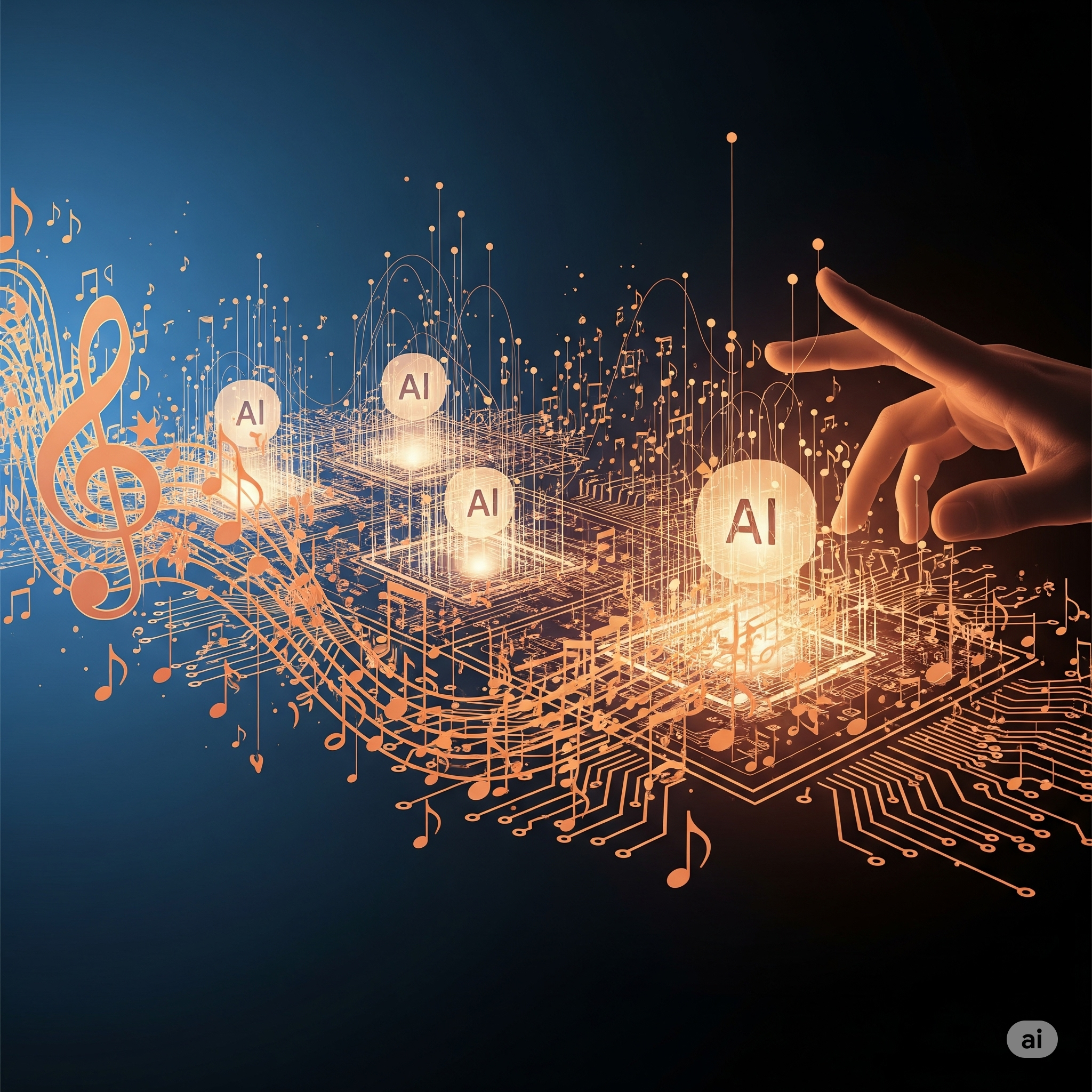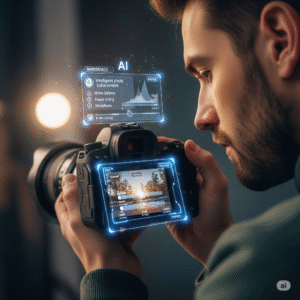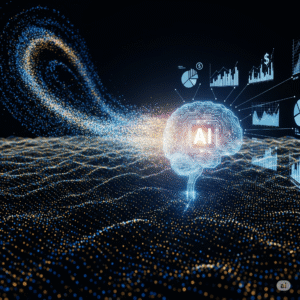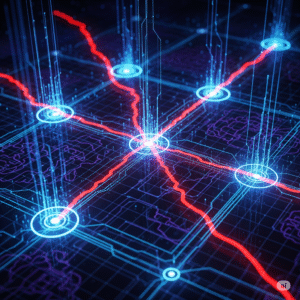The pulsating rhythm of innovation echoes through the music industry, propelled by an unlikely maestro: Artificial Intelligence. What was once the exclusive domain of human creativity – the intricate dance of melodies, harmonies, and rhythms – is now being augmented and transformed by intelligent algorithms. AI music composition is no longer a futuristic fantasy; it’s a vibrant reality, empowering artists, producers, and businesses to explore unprecedented avenues in sound design and musical creation. This isn’t about replacing human artistry, but rather about providing powerful new tools that unlock previously unimaginable creative potential.
From generating bespoke soundtracks for video games to personalizing playlists for millions, AI’s footprint in the audio landscape is expanding rapidly. The synergy between human intuition and algorithmic precision is redefining how music is conceived, produced, and consumed. This blog post delves into the profound impact of AI music composition and AI audio production, exploring how these technologies are not just transforming the artistic process, but also creating new business opportunities and driving profit across various sectors.
The Dawn of Algorithmic Melodies: What is AI Music Composition?
At its core, AI music composition involves using artificial intelligence algorithms to generate new musical pieces. This can range from simple melodies and chord progressions to complex, multi-instrumental orchestrations, and even entire songs with lyrics and vocals. The AI learns from vast datasets of existing music, identifying patterns in genre, style, harmony, rhythm, and instrumentation. Once trained, it can then generate original compositions based on these learned parameters, often with remarkable originality and coherence.
This process leverages various AI techniques, primarily machine learning models like Recurrent Neural Networks (RNNs) and Generative Adversarial Networks (GANs). RNNs are adept at processing sequential data, making them ideal for understanding and generating musical sequences. GANs, on the other hand, consist of two competing neural networks – a generator that creates new music and a discriminator that evaluates its authenticity – leading to increasingly realistic and compelling outputs. The beauty of AI music composition lies in its ability to quickly produce a multitude of variations, allowing composers to rapidly prototype ideas and explore diverse sonic palettes that might otherwise take countless hours.
AI in Action: Revolutionizing Audio Production
Beyond pure composition, AI is also making significant strides in AI audio production, streamlining workflows and enhancing the quality of audio. Imagine an AI that can intelligently master your tracks, separate individual instrument stems from a mixed song, or even remove unwanted noise from a vocal recording. These capabilities, once requiring extensive human expertise and time, are now being automated and refined by AI, democratizing high-quality audio production.
AI-powered tools are being integrated into Digital Audio Workstations (DAWs), offering intelligent mixing suggestions, automatic equalization, and dynamic processing. This allows musicians and producers to focus more on the creative aspects of their work, leaving the more technical and repetitive tasks to the AI. The result is a more efficient, accessible, and often higher-quality audio product. The rise of AI audio production also opens doors for independent artists, enabling them to achieve professional-grade results without the need for expensive studio equipment or extensive technical knowledge.
Real-World Impact: AI Driving Business Growth in Music
The implications of AI music composition and AI audio production extend far beyond the creative studio. Businesses across various industries are leveraging these technologies to gain a competitive edge, make data-driven decisions, and ultimately increase their profitability.
Consider the burgeoning demand for custom music in advertising, film, and gaming. Traditionally, creating original scores is a time-consuming and expensive process. AI offers a scalable solution, generating unique, royalty-free music tailored to specific moods, genres, and durations in a fraction of the time and cost. This allows companies to create more engaging and personalized content, directly impacting consumer engagement and brand recall.
Furthermore, AI is transforming how music streaming platforms operate. Companies like Spotify and Apple Music extensively use AI to personalize recommendations, curate playlists, and discover new artists. By analyzing user listening habits, preferences, and even emotional responses to music, AI algorithms can provide highly tailored content, leading to increased user retention and subscription rates. This data-driven approach allows these businesses to understand their audience on an unprecedented level, translating insights into tangible profit.
Case Study 1: Empowering Content Creators with Royalty-Free Music
Meet Sarah, a successful YouTube content creator specializing in travel vlogs. For years, Sarah struggled with finding unique, engaging, and most importantly, royalty-free background music for her videos. Licensing fees were often prohibitive, and generic stock music felt uninspired. This limited her creative expression and sometimes delayed her video releases.
Then Sarah discovered Beatoven.ai, an AI-powered music generator. With Beatoven.ai, Sarah can input her video’s mood, genre, and duration, and the AI generates multiple unique music tracks. She can then customize elements like instruments, tempo, and intensity. This has revolutionized her workflow. “Before Beatoven.ai, I spent hours sifting through libraries or negotiating licenses,” Sarah explains. “Now, I can generate a custom soundtrack that perfectly fits my video’s vibe in minutes. It’s truly royalty-free, so I never worry about copyright strikes, and it has significantly improved the professional feel of my content, which directly translates to more views and ad revenue.” Beatoven.ai’s fair training practices, ensuring musicians are compensated, also resonated with Sarah’s ethical values, making it a win-win solution for her business.
Case Study 2: Revolutionizing Music Tagging and Discovery for Industry Giants
Consider Musiio, an AI company that provides solutions for the music industry, particularly focusing on intelligent music tagging and search. Large music labels and streaming services often manage catalogues containing millions of tracks. Manually tagging these tracks with accurate genre, mood, instrumentation, and vocal information is an enormous, time-consuming, and often inconsistent task.
Musiio’s AI-powered Tag API (Application Programming Interface) automates this process. By analyzing audio waveforms, the AI can instantly and consistently tag vast libraries of music. ClicknClear, a company specializing in licensing music for competitive sports, utilizes Musiio’s technology. Chantal Epp, Founder of ClicknClear, states, “We at ClicknClear are great advocates of leveraging technology to help maximize the opportunities to increase music revenue – so I’m excited to be working with Musiio’s AI to quickly get reliable, consistent tagging of our rapidly growing catalog.” This accurate and scalable tagging allows for more efficient music discovery, better search functionality for users, and more precise monetization opportunities, directly contributing to ClicknClear’s operational efficiency and revenue growth. Similarly, companies like Beatstars use Musiio to tag millions of tracks daily, dramatically improving their content management and user experience.
Key AI Tools for Music Composition and Audio Production
The market is brimming with innovative AI tools that empower both professionals and aspiring creators. Here are a few prominent examples:
- AIVA (Artificial Intelligence Virtual Artist): AIVA (https://www.aiva.ai/) is a leading AI music composition engine that specializes in creating emotional soundtracks for films, commercials, games, and more. It has composed music for various projects and is recognized by SACEM (a French society of authors, composers, and publishers of music).
- SOUNDRAW: SOUNDRAW (https://soundraw.io/) is an AI music generator that offers royalty-free beats for creators. Users can customize genre, mood, instruments, and length, making it ideal for background music in videos, podcasts, and presentations.
- Amper Music (acquired by Shutterstock): Amper Music (https://www.shutterstock.com/business/music/amper-music) was a pioneer in AI music composition, enabling users to generate original, royalty-free music by simply specifying genre, mood, and length. Its technology is now integrated within Shutterstock’s offerings, providing a powerful resource for content creators.
- LANDR: While primarily known for its AI mastering capabilities, LANDR (https://www.landr.com/) has expanded its AI suite to include tools like LANDR Composer for generating chord progressions and LANDR Stems for isolating audio tracks. This comprehensive platform supports musicians throughout their production journey.
- Adobe Podcast (Enhance Speech): For AI audio production, Adobe Podcast (https://podcast.adobe.com/enhance) offers an “Enhance Speech” feature that uses AI to remove noise and echo from voice recordings, making even amateur recordings sound professionally produced. This is a game-changer for podcasters, voiceover artists, and online educators.
- LALAL.AI: LALAL.AI (https://www.lalal.ai/) is an AI-powered stem splitter that allows users to extract vocals, instruments, drums, bass, and other elements from any song with remarkable precision. This is invaluable for remixers, DJs, and producers seeking to isolate specific audio components.
Beginner-Friendly Tips for Implementing AI-Powered Music Workflows
Diving into AI music composition and AI audio production might seem daunting, but it’s more accessible than ever. Here are some beginner-friendly tips to get started:
- Start with a Clear Vision: Before you even open an AI tool, have a clear idea of what you want to achieve. What genre, mood, and instrumentation are you aiming for? The more specific your input, the better the AI’s output will be. Think of the AI as a highly skilled intern – it needs clear instructions.
- Experiment with Prompts and Parameters: Don’t be afraid to play around! Most AI music generators allow you to tweak various parameters like tempo, intensity, emotional curve, and instrumentation. Try different combinations to see how the AI responds and what unique sounds you can unearth.
- Use Reference Tracks: Many AI tools allow you to input reference tracks. If you have a specific song or style in mind, providing a reference can help the AI understand your desired aesthetic more accurately.
- Embrace Iteration and Refinement: AI-generated music isn’t always perfect on the first try. Treat the AI as a creative partner. Generate multiple versions, select the best elements, and then use your human ear and musical knowledge to refine and polish the composition. Post-production – mixing, mastering, and adding human-played elements – is crucial for a truly professional sound.
- Focus on Specific Tasks First: Instead of trying to generate an entire symphony, start with simpler tasks. Use AI to create a drum beat, a bassline, or a melody. Once you’re comfortable, you can combine these AI-generated elements with your own creations.
- Understand Licensing and Copyright: While many AI music tools offer royalty-free music, it’s essential to understand the licensing terms. Some platforms might require attribution, while others offer full commercial rights. For music intended for distribution on streaming platforms, current copyright law generally states that only human-generated content can be copyrighted. While this area is evolving, it’s a critical consideration for artists and businesses looking to monetize AI-assisted creations.
The Human Touch in an AI-Powered Future
As AI continues to advance, the conversation naturally shifts to the role of human creativity. Will AI replace musicians and producers? The consensus among industry experts is a resounding “no.” Instead, AI is emerging as a powerful co-pilot, an invaluable assistant that augments human capabilities. AI can handle repetitive tasks, generate endless ideas, and provide technical precision, freeing up human artists to focus on the truly creative, emotionally resonant aspects of music.
The future of AI music composition and AI audio production is one of collaboration. It’s about combining the algorithmic brilliance of machines with the irreplaceable intuition, emotion, and storytelling ability of human artists. This partnership promises a new era of musical innovation, where creative boundaries are not just pushed, but shattered, opening up a universe of sonic possibilities for artists and businesses alike
Why the AI Skills Gap Is the Biggest Challenge for Future-Ready Businesses



